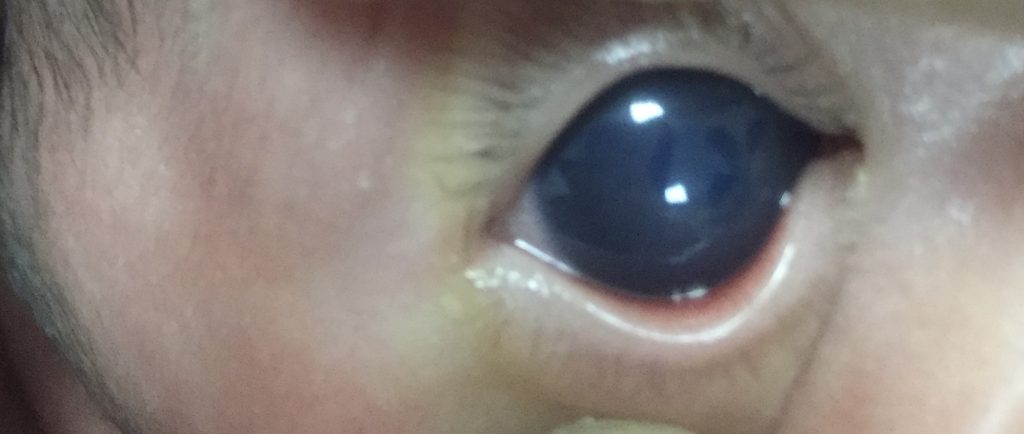Buphthalmos, also known as buphthalmia, refers to an inherited congenital condition characterized by the enlargement of one or both eyes. This enlargement becomes apparent either at birth or within the first few months of life. Buphthalmos can occur unilaterally (affecting one eye) or bilaterally (affecting both eyes).
The term “buphthalmos” originates from the Greek words for “ox” and “eye,” reflecting the enlarged eye resembling those of an ox or a cow. The ancient Greek physician Hippocrates is credited with first identifying this condition.
The development of buphthalmos is linked to autosomal recessive genetics, meaning both parents must pass on an altered gene to their child for the condition to manifest. If both parents carry the altered gene, there is a one in four chance that their child will inherit the autosomal recessive gene. It is important to note that parents may be unaware that they carry these genes.
The primary cause of buphthalmos is often primary congenital glaucoma or primary infantile glaucoma. These conditions result in optic nerve damage and can lead to vision loss. The damage is believed to be caused by an accumulation of fluid and increased pressure within the eye, known as intraocular pressure (IOP).
Primary congenital glaucoma manifests from birth, while primary infantile glaucoma occurs between birth and the age of three.
Other causes of buphthalmos include:
Aniridia: A rare condition affecting the iris (colored part of the eye), where the iris is partially or completely absent, potentially impacting vision.
Neurofibromatosis type 1: Primarily an inherited condition characterized by the growth of tumors on nerves, which can affect the eyes.
Sturge-Weber syndrome: A congenital condition leading to excessive growth of blood vessels and the formation of angiomas. This syndrome can affect the skin, brain, and eyes.
Birth injury: Injuries occurring during childbirth that can harm the eyes.
The most noticeable indication of buphthalmos occurs during infancy, where the affected individual has enlarged eyeballs. This enlargement can affect either one or both eyes. Depending on the underlying cause of buphthalmos, additional symptoms may be present, including:
Excessive tearing, watery eyes, or easy eye irritation, sensitivity to light (photophobia), eye twitching or frequent blinking, cloudiness of the cornea, which is typically clear and serves as the “window” of the eye and stretching, thinning, and potential breaks in the cornea.
If parents observe any concerns related to their child’s eyes, they should consult a healthcare professional. In the case of buphthalmos and congenital glaucoma, early detection and treatment are crucial for optimal vision.
To diagnose buphthalmos, the healthcare provider may perform the following tests, sometimes requiring anesthesia:
Comprehensive eye examination: This allows the provider to assess the cornea for cloudiness, tears, or swelling. They also measure the size of the eye and examine the optic disk for cupping, where the optic nerve exits the eye.
Retinoscopy: A test to identify any refractive errors, such as myopia (nearsightedness).
Gonioscopy: This test evaluates the drainage system of the eyes, as healthy eyes continually produce and drain fluid. In glaucoma, fluid backup increases pressure and damages the optic nerve.
Ultrasound biomicroscopy: This noninvasive test provides detailed images of the front part of the eye, aiding in the detection of drainage issues. It offers more precise imaging compared to a regular ultrasound (sonogram).
Treating buphthalmos focuses on managing intraocular pressure. Various approaches are available to reduce pressure, including medication. Eye drops or other topical treatments may contain beta blockers, prostaglandin analogs, or carbonic anhydrase inhibitors.
Surgical procedures may be employed to facilitate fluid drainage and alleviate intraocular pressure. These procedures involve implant placement in the eye, incisions in eye structures, or removal of tissue.
It is important to note that individuals with buphthalmos may require additional treatments for associated conditions, such as neurofibromatosis type 1, Sturge-Weber syndrome, or aniridia. Healthcare providers will assist in managing these conditions alongside buphthalmos.
At The Eye Center- Dr. Mahnaz Naveed Shah & Associates our team of eight ophthalmology subspecialists/ eye specialists, eye surgeons who are considered amongst the very best eye specialists in Karachi and in Pakistan, have the diagnostic and treatment capabilities to treat from the simplest to the most complex patients. We work hard to provide our patients with the best possible medical and surgical eye care, in a state of the art purpose built eye care facility. We offer the entire array of medical, laser and surgical treatments to help provide patients the best possible care in the most efficient, safe and ethical manner.
If you need an appointment, please contact us at 03041119544 during our working hours or leave us a WhatsApp message at +923028291799 and someone will connect with you. Walk-in appointments are also available for emergencies. We can also be reached through our web portal on www.surgicaleyecenter.org


